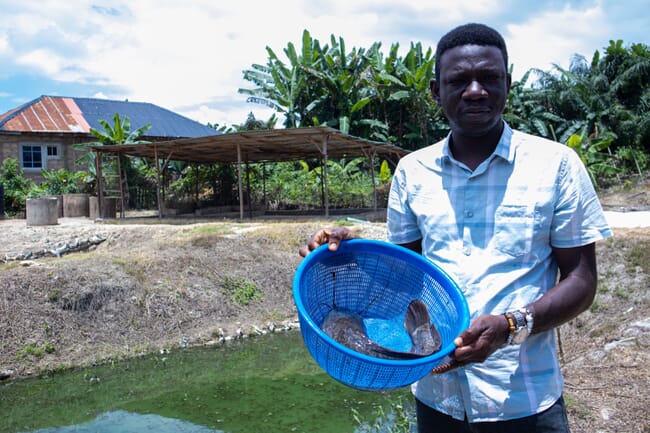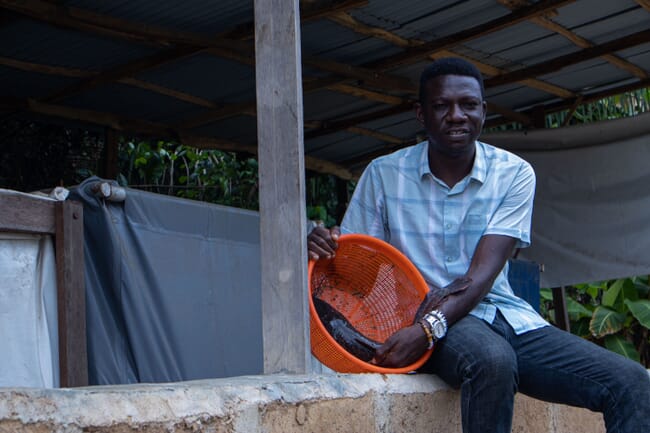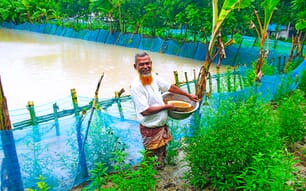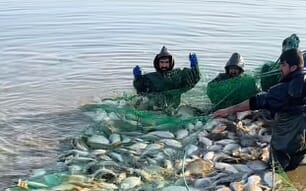
What inspired you to embark on a career in aquaculture?
When I completed my National Youth Service Corps (NYSC) programme in 2014, I moved into a new city, Ibadan, and started training with a veterinarian. I was living in the city and was interested in starting an agribusiness of my own. But I was limited in space (land), resources (finance) and knowledge (the business side of agriculture).
When a neighbour offered me his garage to use for anything I wanted, fish tanks were the easiest venture I could engage with that fit my profile of limited space and a low budget– so I started with two fish tanks and a few customers. I then discovered that I needed an increased water volume and space to rear more fish. I tried to acquire imported tarpaulin ponds but it was too expensive for me. So I went to Lagos, sourced materials and designed my own mobile tarpaulin ponds. Asher Royal Produce Limited was founded in 2014 and over 500 of our fish ponds have now been deployed across the 36 states of Nigeria.
What size is your farm and what species do you produce?
We have four farms that we operate on our own, we also currently manage 11 of our partner farms and have a supervisory role with six farms. We run a BOT (build, operate and transfer) model. So we build the farm, operate it for one year in tandem with the financiers staff and then transfer and hand it over completely after the preassigned time.
In our headquarters in Ibadan, we have 36 earthen ponds of 20 x 10 metres each, several tanks and tarpaulin fish ponds. We produce 26 tonnes of catfish, 12 tonnes of tilapia and 3 tonnes of heterotis from here yearly.
From these 36 ponds, we have a 54,000 fish capacity for each cycle. Our sales for the three cycles each year are worth 150 million naira (€79,515).
What sort of production systems do you operate?
We use earthen ponds for our catfish, tilapia, heterotis, and common carp farms. We use tarpaulin fish ponds for farms in urban environments. We use wolffia as one of the feeds for our herbivorous fish (tilapia, heterotis and common carp) and black soldier fly for our carnivorous fish (catfish). Black soldier fly is only a supplementary feed but the overall cost of feed is reduced and it has increased our farm's profitability by 11 percent.
What equipment and skills do you need to operate them?
We use solar pumping machines, both submersible and mud pumps. We use digital weighing scales, grading equipment, and water monitoring devices. I am currently researching automatic feeders and a solar powered aerator. That would be interesting to have.

How do you source your juveniles?
We currently breed our own catfish and tilapia juveniles but have partner farms that supply us the heterotis and common carp. We collect over 300,000 fingerlings in a year.
What have been the major challenges in setting up and operating your farm?
One of the first challenges we faced when advocating for tilapia was the time it took for tilapia to reach 1 kg. Catfish get to 1 kg in six months using pelletised feeds, but tilapia takes more than one year.
Thankfully, more genetically improved tilapia species are available now and the advent of black soldier fly farming is helping to alleviate the high cost of commercial feed.
Fuel costs and the inadequate power supplies for pumping water are also huge challenges.
What is your biggest worry at work?
My biggest worries are flooding and political instability. Another worry is effectively managing over 30 staff in different states in the country. We just have to manage a lot of shenanigans and scheming.
What is your typical day at work?
Because my company manages a number of fish farms, I work with a team. I have a local team that includes the farm manager or supervisor of each farm, a supervising team that travels between farms, and an executive team that runs the whole company.
I try to visit one farm each week and get very involved in the farming activities. So I try to target that visit for when they are sorting fish, or taking average weight or during sales. When I am on a farm, I wake up quite early – sometimes 5:30 am – to walk around the farms, observe the fish, and pray. It’s a good quiet time routine. I then watch to see the time the staff would come in and how efficient their activities are. We need to reiterate and cross check our processes to ensure we are very efficient in our schedules.

What is the most interesting experience you’ve had in aquaculture?
Building a farm remotely in Ghana from Nigeria. I did a virtual training session for the client and supervised the building of his farm up until his first sales. It was a very interesting journey.
What is your biggest achievement to date?
I am proud that we have been able to engage quite a number of youths in aquaculture. Young people often associate agriculture with drudgery and menial work. But we have shown several youths that there is a whole value chain and wide industry and job roles in aquaculture.
Are there any individuals or organisations that have particularly helped you?
I recently stumbled upon Willy Fleuren, a Dutch fish farmer who has been farming in Nigeria for years. I stumbled upon his book this year and couldn’t put it down. I have read his two books and I absolutely can relate with his experiences and ideals. Hopefully I get to meet him someday.
Other inspirational figures in agriculture include African Farmer Mogaji [the adopted name of Afioluwa Mogaji] and the former president of Nigeria Olusegun Obasanjo.
If you could solve one issue in the aquaculture industry, what would it be?
I would like more efficient and affordable solar pumping machines. I would also like more efficient and affordable solar post-harvest equipment.

What would be your advice to other fish farmers?
I read about the Kaizen philosophy from the Japanese. I believe that there can always be a constant improvement of working practices and personal efficiency. I think we all should be willing to learn, relearn, and unlearn. Networking is very important too.
Tell us more about your training and mentoring roles?
Starting and managing fish farms across the country means that I have to hire new staff and engage new people. I also have a YouTube channel with a growing following across Africa; this means I have to organise training very regularly because I am usually inundated with inquiries. The training often spills into mentorship and speaking engagements. That is how I got the nickname “Akinfish.” It is actually a very pleasing part of my work because I get to encourage the new entrants and let them know of any research or innovation that is working for me.
Are you using AI in your farms?
I have a master’s degree in geographic information systems (GIS) and have seen first-hand the advantages of data in any enterprise. Remote sensing is huge in aquaculture, as fish density and other water parameters can be monitored and managed remotely. Whilst this is not yet advanced in Nigeria, the potentials and opportunities are present. What is currently operational are farm management systems and software that enable tracking of resources and processes in a farm. That is our current use of AI. However, AI also has real potential in fish handling and water management operations of aquaculture, and I am keen to be in and around that space.
How do you think aquaculture in Nigeria should evolve in order to achieve its full potential?
I think aquaculture in Nigeria has to evolve from just basic production to exploring the whole value chain of fish produced. I know there are now fish sausages in the country, but I also know that the cold value chain of our locally produced fish still has a lot of potential to be explored. Once we can handle post-harvest processing better, more of our local fish would find its way to our plates. This would stimulate growth in the industry and encourage the government to allow more of our natural water resources to be utilised for aquaculture.
What is your ultimate ambition in the aquaculture sector?
I would like to be a leader of aquaculture innovation, marketing and advocacy. And I think our farming systems can and should be improved upon.








